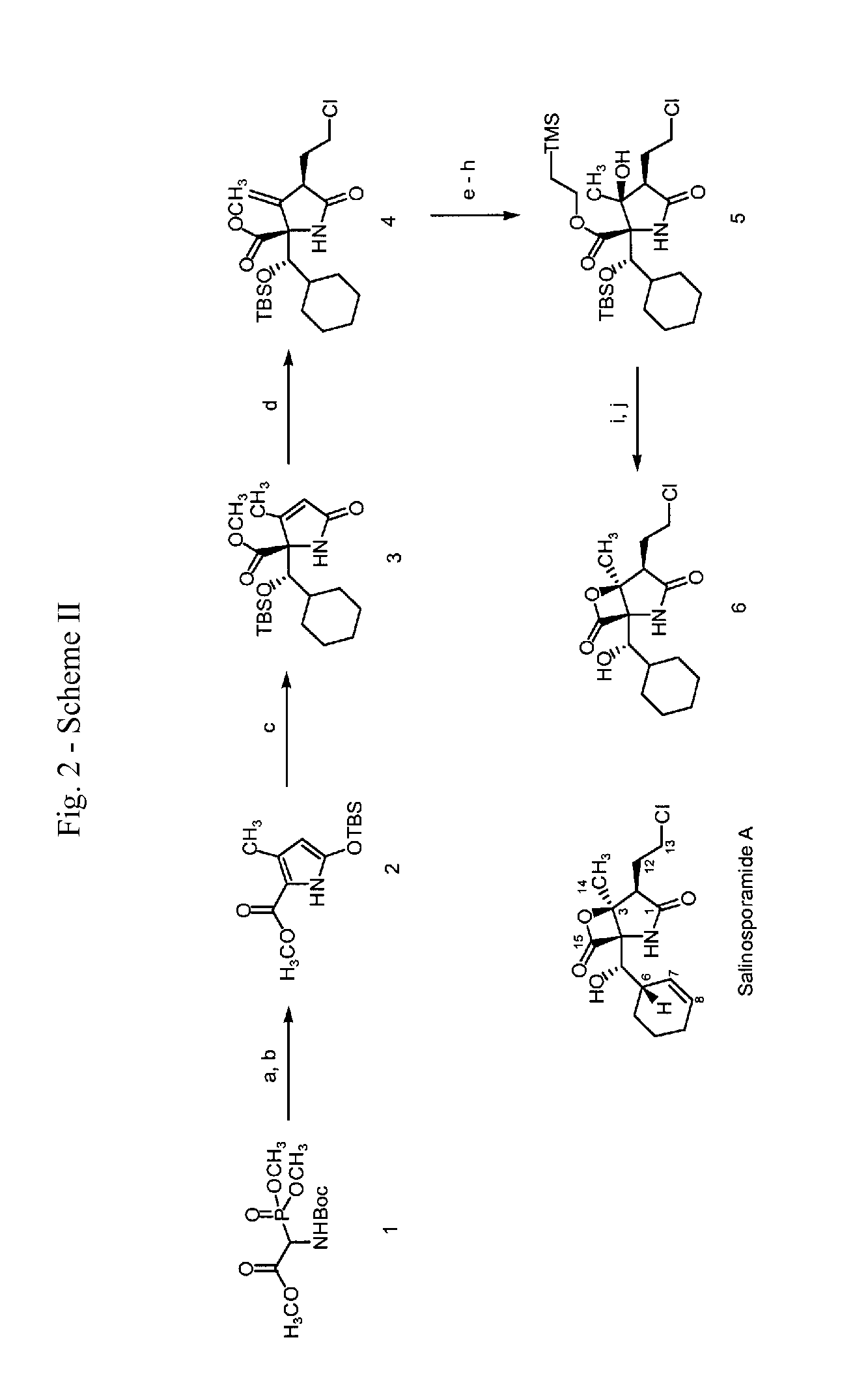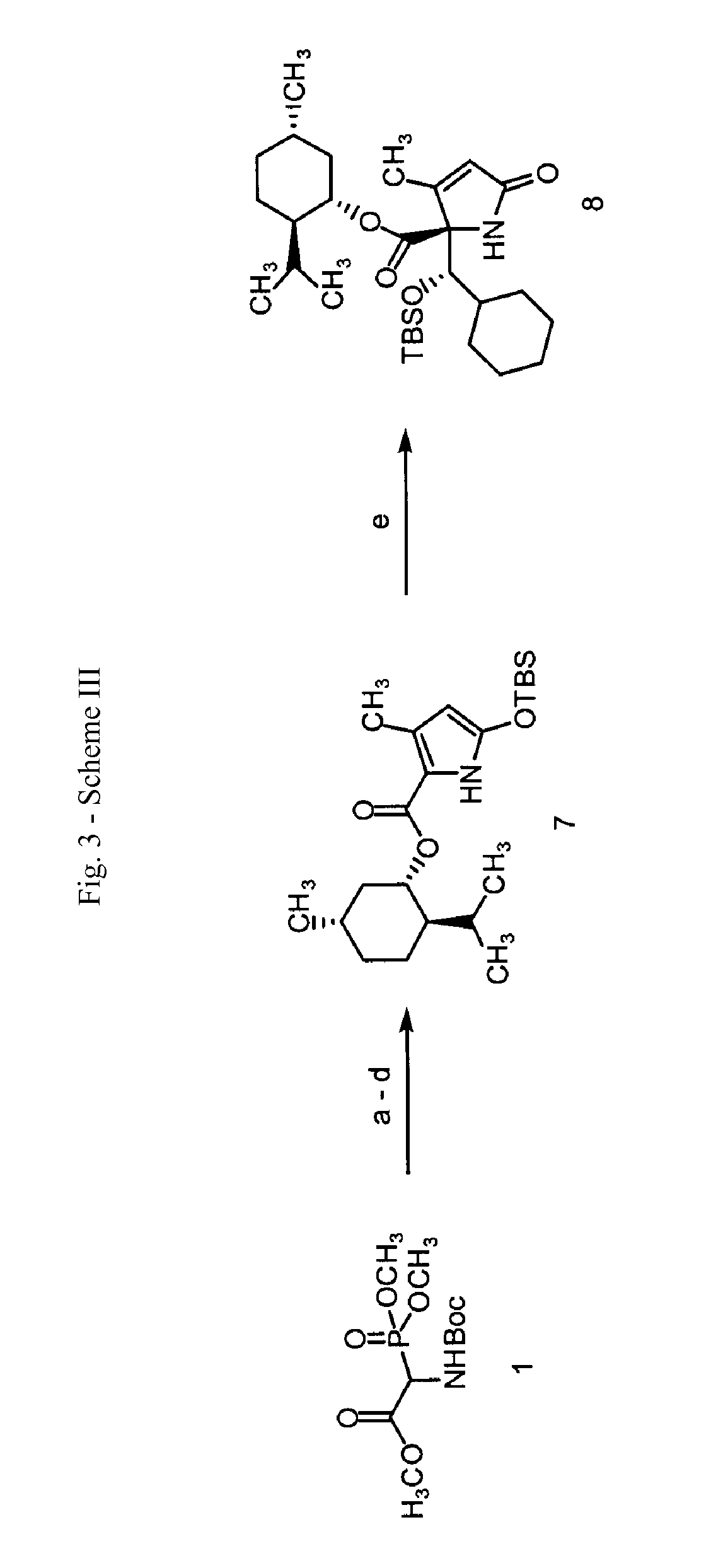Analogs of salinosporamide A
a technology of salinosporamide and analogues, applied in the field of analogues of salinosporamide, can solve the problems of protein buildup and clogging of cellular machinery
- Summary
- Abstract
- Description
- Claims
- Application Information
AI Technical Summary
Benefits of technology
Problems solved by technology
Method used
Image
Examples
example 1
[0122]
3-Methyl-5-oxo-2,5-dihydro-pyrrole-1,2-dicarboxylic acid 1-tert-butyl ester 2-methyl ester
[0123]A solution of tert-butoxycarbonylamino-(dimethoxy-phosphoryl)-acetic acid methyl ester (20.0 g, 67 mmol, 1 equiv), 2,2,6-trimethyl-[1,3]dioxin-4-one (43.96 ml, 47.8 g, 336 mmol, 5.0 equiv), and 2,6-lutidine (11.71 ml, 10.77 g, 101 mmol, 1.5 equiv) in toluene (200 ml) was heated at reflux for 16 h. The reaction mixture was allowed to cool to 23° C. and was concentrated. The residue was purified by flash column chromatography (5% ethyl acetate-dichloromethane initially, grading to 8% ethyl acetate-dichloromethane) to give 3-methyl-5-oxo-2,5-dihydro-pyrrole-1,2-dicarboxylic acid 1-tert-butyl ester 2-methyl ester (14.74 g, 86%) as a yellow oil.
[0124]
[0125]1H NMR (500 MHz, CDCl3)δ: 5.92 (s, 1 H, CHC(O)OCH3), 4.94 (s, 1 H, CHC(O)N), 3.79 (s, 3 H, CHC(O)OCH3), 2.06 (s, 3 H, CH3CCHC(O)N), 1.50 (s, 9 H, (CH3)3COC(O)N) 13C NMR (100 MHz, CDCl3)δ: 168.4, 167.4, 154.8, 148.3, 124.2, 83.4, 66.9, ...
example 2
[0126]
5-(tert-Butyl-dimethyl-silanyloxy)-3-methyl-1H-pyrrole-2-carboxylic acid methyl ester
[0127]tert-Butyldimethylsilyltrifluoromethanesulfonate (9.99 ml, 11.49 g, 43.5 mmol, 3.0 equiv) was added to a stirring solution of 3-methyl-5-oxo-2,5-dihydro-pyrrole-1,2-dicarboxylic acid 1-tert-butyl ester 2-methyl ester (3.7 g, 14.5 mmol, 1.0 equiv) and 2,6-lutidine (5.07 ml, 4.66 g, 43.5 mmol, 3.0 equiv) in dichloromethane (100 ml) at 23° C. The mixture was stirred at 23° C. for 15 h, then washed with pH=7 buffer solution (30 ml). The aqueous layer was extracted with two 40 ml portions of dichloromethane. The combined organic layers were dried over sodium sulfate. The solids were filtered and the filtrate was concentrated. The residue was purified by flash column chromatography (3% ethyl acetate-hexanes initially, grading to 6% ethyl acetate-hexanes) to afford 5-(tert-Butyl-dimethyl-silanyloxy)-3-methyl-1H-pyrrole-2-carboxylic acid methyl ester (3.46 g, 89%) as a yellow oil.
[0128]
[0129]1H ...
example 3
[0130]
2-[(tert-Butyl-dimethyl-silanyloxy)-cyclohexyl-methyl]-3-methyl-5-oxo-2,5-dihydro-1H-pyrrole-2-carboxylic acid methyl ester
[0131]tert-Butyldimethylsilyltrifluoromethanesulfonate (2.40 ml, 2.75 g, 10.4 mmol, 2.0 equiv) was added dropwise over 8 min to a stirring solution of 5-(tert-butyl-dimethyl-silanyloxy)-3-methyl-1H-pyrrole-2-carboxylic acid methyl ester (1.4 g, 5.2 mmol, 1.0 equiv) and cyclohexanecarbaldehyde (0.94 ml, 0.87 g, 7.8 mmol, 1.5 equiv) in dichloromethane (100 ml) at −78° C. The resultant solution was stirred at −78° C. for 2 h, then pH=7 buffer solution (50 ml) was added. The organic layer was washed with brine solution (50 ml), and dried over sodium sulfate. The solids were filtered and the filtrate was concentrated. The residue obtained was purified by flash column chromatography (5% ethyl acetate-dichloromethane initially, grading to 8% ethyl acetate-dichloromethane, then to 10% ethyl acetate-dichloromethane) to give 2-[(tert-butyl-dimethyl-silanyloxy)-cyclo...
PUM
| Property | Measurement | Unit |
|---|---|---|
| pore size | aaaaa | aaaaa |
| pore size | aaaaa | aaaaa |
| temperature | aaaaa | aaaaa |
Abstract
Description
Claims
Application Information
 Login to View More
Login to View More - R&D
- Intellectual Property
- Life Sciences
- Materials
- Tech Scout
- Unparalleled Data Quality
- Higher Quality Content
- 60% Fewer Hallucinations
Browse by: Latest US Patents, China's latest patents, Technical Efficacy Thesaurus, Application Domain, Technology Topic, Popular Technical Reports.
© 2025 PatSnap. All rights reserved.Legal|Privacy policy|Modern Slavery Act Transparency Statement|Sitemap|About US| Contact US: help@patsnap.com



